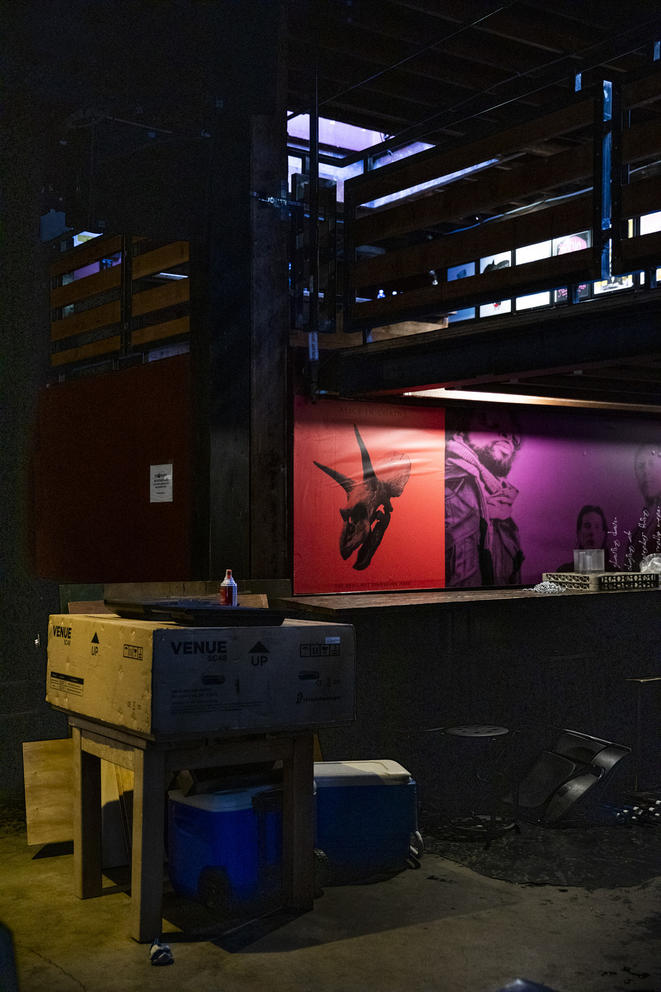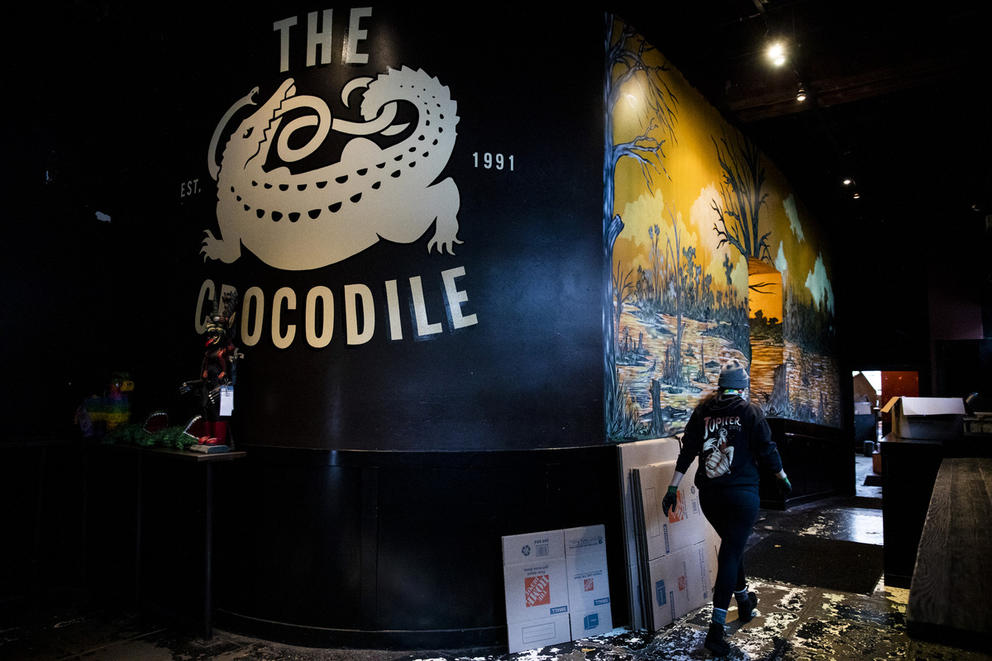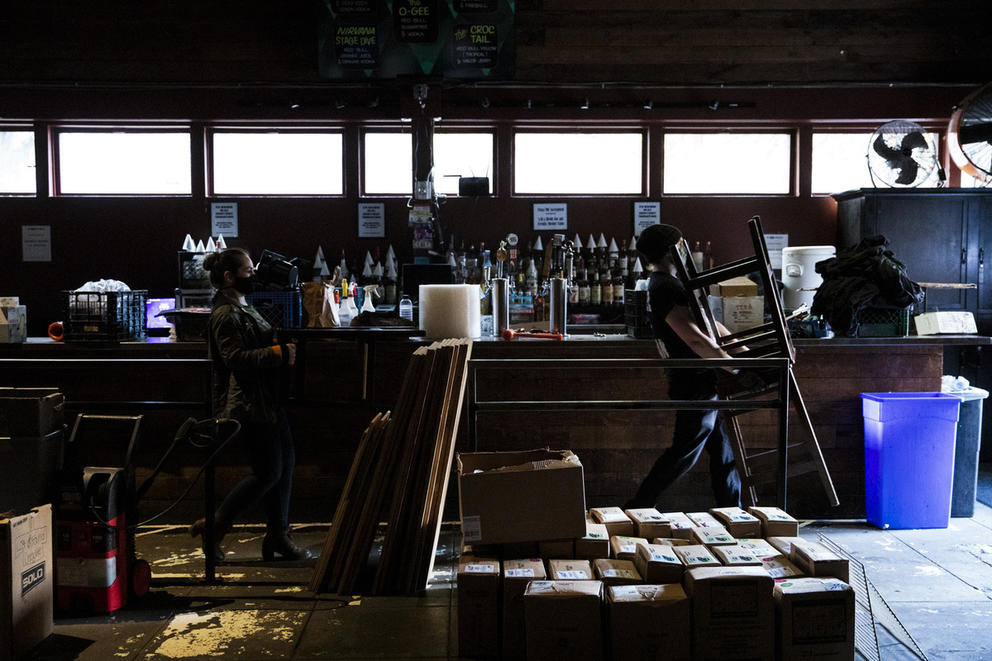The Croc’s joist was a structural beam in the middle of the club that held up the roof. It was positioned about 10 feet from the stage in the venue’s original layout, partly blocking the crowd’s view of the stage. Everyone in Seattle had a different name for the impediment — to some it was a pole, others a post, while in construction lingo it may have been most accurately a “column,” though that sounds far too stately. My friends and I settled on “joist” because the word itself sounded annoying.
The building hadn’t been constructed to be a club, and what you could call a “stage” was basically a riser about a foot above the ground. Sightlines were problematic when the place was packed, and the joist added another obstruction.
That is unless you went early, as I often did, and you were able to grab the position in front of the joist to lean on it. If you arrived late, and Mudhoney or Nirvana was onstage, you might find the only space left in the tiny club was standing behind the view-blocking joist. Which was frustrating, but also part of the whole Croc experience.
The joist, alas, came down in 2009, when the Crocodile was remodeled. The club got another 10 years in the freshened-up space, until COVID-19 temporarily closed it, and every other Seattle club, this past spring. But nearby development had threatened the Croc long before the coronavirus, and when the owners were unable to get a new lease, they had to shift gears.
Instead of closing permanently, a fate facing many music clubs in town, the Crocodile is instead moving a few blocks north, to the former El Gaucho steakhouse location, at First Avenue and Wall Street. That space will be remodeled and, with any luck, ready by the time live music reopens, likely in late fall of 2021. The new club will have a bigger capacity of 750, a bump of 250 people.
“We did everything in our power to stay in this one spot,” co-owner Adam Wakeling told me this week from the Second Avenue space. The old building’s landlord never gave an explanation to the Croc for not renewing the lease, but the rest of the block has seen nightlife businesses (Tula’s, Shorty’s) edged out, and a high-rise is rumored. “In the end, it’s not our building,” Wakeling says.
That means the corner of Second and Blanchard, which has hosted live music shows for over four decades, will go quiet.
I first walked into the business on that corner in the 1980s. It was a Greek restaurant called The Athens. I was a college kid then, and Belltown, which was pretty seamy and full of merchant mariners on leave, appealed to me because it seemed like something out of a Charles Bukowski novel. There were dozens of cheap bars and empty loft spaces in the area then, and it attracted artists and musicians.
The Athens had a banquet room in the back, and it began to book punk and new wave shows. I had started working for The Rocket music magazine, which was just two blocks away, and the cheap Greek food and live bands made it a regular stop. Eventually, though, the restaurant closed, and the space sat vacant for a time.
It was resurrected as the Crocodile Café & Live Bait Lounge on April 30, 1991. Locals would pretty much always call it the Croc. Stephanie Dorgan, an attorney, founded the club with a couple of business partners. A year later, Dorgan would meet and eventually marry Peter Buck of R.E.M. His star wattage helped illuminate the place, particularly when his musical friends ended up onstage. Still, credit for the vibe of the club goes to Dorgan (who, like many of the women who helped create Seattle’s music scene, saw her contribution often overlooked by a more famous spouse).
Because of the timing of the opening in 1991, some think the Croc helped make “grunge,” but it was actually late to that game. Nirvana played “Smells Like Teen Spirit” exactly two weeks before the Croc opened, across town at the OK Hotel in Pioneer Square. No one knew in early 1991 that Seattle would become the center of the musical universe for a bit, but most of the bands that would soon be famous were well launched by the time the Croc opened. It certainly nurtured talent but, at a few hundred seats, it was too small to serve as a regular stop for superstar bands.
But when Seattle became “Seattle” in the fall of 1991, as Nevermind started up the charts, music and musicians needed a homeroom of sorts, and the Crocodile checked all the boxes. It was both a club at night, and a hangout during daylight hours. Serving cheap all-day breakfast, the café became an informal office for Seattle music. Sub Pop was just a few blocks away, as was The Rocket, and the Seattle vibe was such that Kurt and Courtney could eat lunch there and not be harassed.
It was the music room, though, even with the joist, that cemented the Croc’s history. Musicians just loved playing in the room because of how it sounded, the intimacy of the size and the lack of pretension. “Always the best gig in Seattle,” local musician Jayson Jarmon recalled.
Marty Jourard of the Motels played the club several times, in various bands, and described it to me this week as “a real rock club.” When I asked him what that meant, he said it “was run by people who loved music,” had a great sound system (courtesy of longtime soundman Jim Anderson) and “was the kind of place you just keep going to.” Exactly.
In 2013, Rolling Stone ranked it as the seventh best club in the U.S., and it made The Guardian’s top 10 list, as well. It was the place to play in Seattle, both for local bands who felt like they’d made it when they sold out the 500-capacity room, and for national touring bands who felt the club represented everything about Seattle. “I think you could make a pretty good case that in the early 1990s, the Crocodile was the best music venue in America, maybe the world,” said Peter Blackstock, music critic at the Austin American-Statesman.
And though the club didn’t launch grunge, everyone in grunge played there at some point. Nirvana opened up for Mudhoney in 1992, at a gig with an admission of $3, because, well, because that seemed like a Seattle thing to do. Pearl Jam pulled the same feat, opening up for Cheap Trick in 1998. The club also hosted the Gits, Hole, 7 Year Bitch, Sunny Day Real Estate, Tad, Death Cab for Cutie, Modest Mouse, Mad Season and countless other locals over the years.
It was also a place where touring bands played on their way up, as their first Seattle stop, including Green Day, Arctic Monkeys, Jeff Tweedy, the Strokes, Sam Phillips, Aimee Mann, T-Bone Burnett and Beck. Legends like R.E.M. and Yoko Ono played the club because of Buck’s connections. Patti Smith did a sold-out 2005 show so rooted in my memory and history that an entire chapter in my (unfinished) memoir is just about that show.
And at every one of those concerts there was the joist, standing forever solid, a reminder that even when you were at ground zero for the Seattle music scene, and maybe the world’s music scene at the time, you really were just in the banquet room of a dive-y former Greek restaurant.
As Seattle grew and changed, so did the Crocodile. What had once been a low-rent neighborhood became something entirely different, as tech hungry South Lake Union blossomed. Operating a music club has never been an easy task in Seattle, but between noise complaints from condo neighbors, parking hassles and rent increases, the Croc’s fate at the swing of a wrecking ball has been rumored for years. There are almost no single-story buildings left in the area, as is the case near The Showbox venue, which is fighting a high-rise development.
The Croc has already had a few lives. Under Dorgan the club closed in 2007 for financial struggles. It reopened in 2009 with a new management group, including Wakeling. The group remodeled, expanded into a slightly larger music room, added a balcony for all-ages shows and brought in a wood-fired pizza oven.
In the past decade, the club was successful and usually packed with a diverse selection of touring bands. Wakeling is one of several co-owners, including Alice in Chains’ Sean Kinney and manager Susan Silver. Silver, like Stephanie Dorgan, is one of the unsung women who have served as principal architects of the Seattle scene in so many ways, booking early shows and managing Soundgarden and Alice in Chains.
But even with a crew of “people who love music,” the owners of the Croc couldn’t defeat the forces of development. “We have literally been trying for a year to stay in this location,” Wakeling said. “We tried.”
That the club found a new location nearby is a bit of kismet. Wakeling says it may also indicate potential positives coming out of the devastation COVID-19 caused to local businesses. There will — eventually — be opportunity and new life in empty spaces. The announcement that the Crocodile is moving happened to arrive the same week as positive COVID-19 vaccine news, a sign that music and gatherings will get back to normal.
Every club in Seattle — all closed for nine months now, and likely another nine to come — is facing crisis, though. Wakeling says the Croc had another half million dollars in rent due over the upcoming nine months for an empty venue, even if it had been able to extend its lease. For many music clubs in Seattle, and all over the world, this is a hit that is too big to handle. The Croc will move on, but estimates are that a majority of clubs won’t survive without government assistance (the Save Our Stages Act is still tied up in the U.S. Congress, but you can support clubs right now through Keep Music Live).
The forthcoming Croc music space at First and Wall will not be so new to some. I saw shows in the same room, underneath El Gaucho, in the 1980s, when it was the Sailors Union of the Pacific. Bikini Kill, Radiohead, the Posies and the Presidents of the U.S.A. played there, and many others.
The new Crocodile “complex” will include the fancy Pampas Room bar, left over from El Gaucho; the 18-room hotel upstairs; a comedy club in the former Big Picture movie theater space; and, as centerpiece, a music room holding 750.
“We are transferring as much of the décor as we can,” Wakeling said. “We are hoping to create a beautiful, better space.”
As for the old Crocodile, Wakeling said the walls were being taken down this week and everything will be out by the end of the month. If you want to reminisce on what it used to look like, the club was used as a backdrop in a number of movies, including Singles, Georgia and Lucky Them, and many MTV documentaries.
The location has long been a tourist destination. “People come from all over the world to take a picture in this club,” Wakeling said. “We are going to be losing that, but I don’t want this club just to be a building that these people played in.”
I’m the nostalgic type, so I asked Wakeling what happened to the joist that I spent so many hours leaning against, watching Seattle music blossom.
“It’s still in the current Croc,” he said. When the remodel happened, the joist was moved and used again. “[It was] saved as a memorial to all the pain and suffering of not being able to see behind it for years,” Wakeling said.
Though the Croc’s owners are carting all of the art and decorations out of the current space and into the new one, the infamous joist is not moving.
I hated that joist, until I grew to love it. Maybe it is fitting that the joist will be entombed with the rest of the original Greek restaurant, at least until the Second and Blanchard building gets demolished and hauled off.
When it’s gone, I’m not sure if I’ll weep or cheer. I’m guessing it will depend on whether I’ve found something new to lean on.
Get the latest in local arts and culture
This weekly newsletter brings arts news and cultural events straight to your inbox.












